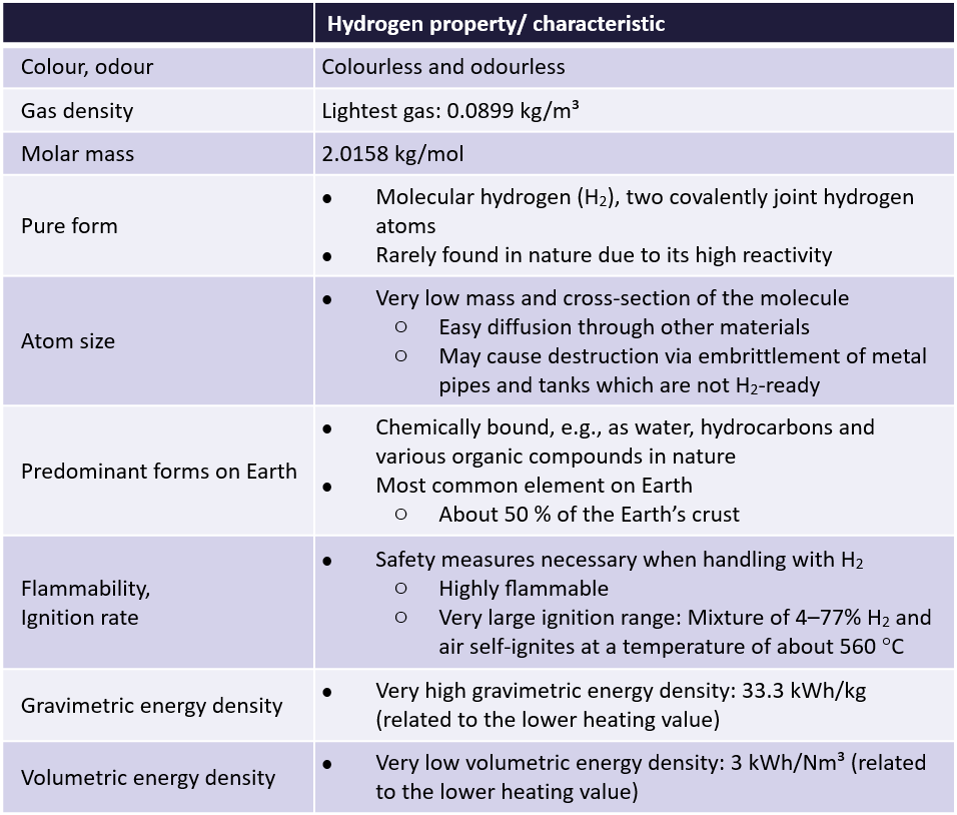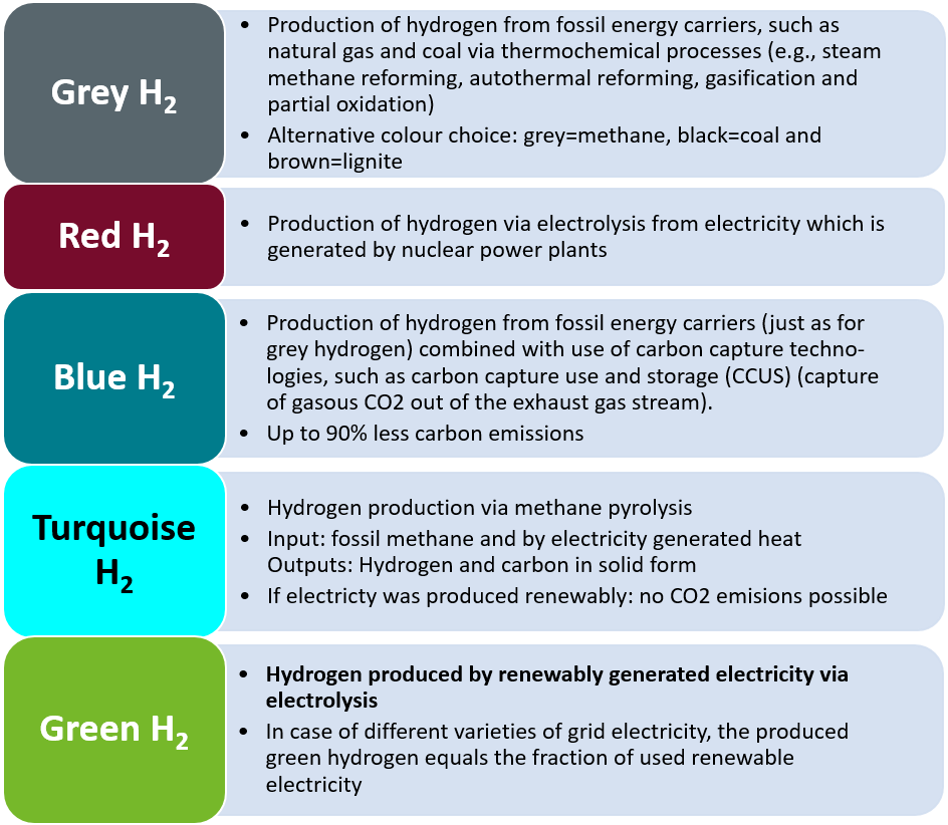2.1 Hydrogen and different Hydrogen Production models
| Website: | Hamburg Open Online University |
| Kurs: | Green Hydrogen |
| Buch: | 2.1 Hydrogen and different Hydrogen Production models |
| Gedruckt von: | Gast |
| Datum: | Samstag, 29. November 2025, 05:52 |
Beschreibung
This chapter provides an overview of hydrogen and its role in mitigating climate change. It covers different methods of hydrogen production and compares their CO2 emissions. The importance of green hydrogen in the energy transition and greenhouse gas reduction is discussed, along with the basics of generating electricity from renewable sources for green hydrogen production. The chapter also explores technical details of green hydrogen production via electrolysis, including comparisons of electrolysis technologies and examples of electrolysers in operation or planned in Northern Germany.
Properties and characteristics
Hydrogen is the first element of the periodic table of elements and thus has the lowest atomic mass of all elements. Therefore, when planning on using hydrogen as an energy carrier, it has to be taken into account, that the handling of hydrogen is different compared to other gases or substances with respect to its properties and very own characteristics. Some of those are stated as a short overview in the table below.

The figure shows that liquid energy carries, such as diesel fuel or petrol (= gasoline), have a significantly larger volumetric energy density compared to hydrogen. Due to the logarithmic scaling of the y-axis, the difference between hydrogen and the other energy carriers in terms of volumetric energy density is actually even higher than it appears at first glance at the diagram. At ambient pressure, even the volumetric energy density of natural gas exceeds that of hydrogen by a factor of about 3. Thus, for hydrogen use either very large tank volumes are needed or an increase of hydrogen’s volumetric energy density is necessary via compression or even liquidisation. More details regarding these challenges will be provided in chapter 3. On the other hand, the figure also shows that hydrogen clearly outperforms other energy carriers in terms of gravimetric energy density.
Different types of hydrogen
As stated in the table above, hydrogen in its molecular form rarely occurs in nature and is chiefly found in chemical bonds. Therefore, production processes are necessary to yield pure hydrogen. Both different primary materials and different processes are used to generate hydrogen.
Today, as highlighted in the pie chart below, most of the globally produced hydrogen originates from natural gas (about 48 %). Hydrogen production from coal amounts to 18 % and 30 % of dedicated hydrogen production is from Oil. The remaining 4 % are produced from electricity with respect to water electrolysis. However, as stated in the previous chapter, this ratio has to change in the future, if emission-free hydrogen should contribute to achieving the climate targets.


Green hydrogen's special importance
Though there are a lot of different options for producing hydrogen, the suitable methods for countries like Germany in order to meet their climate targets are limited. The following figure compares the global warming potential of two grey hydrogen production methods (steam reforming of natural gas and coal gasification) with two green hydrogen production methods (water electrolysis powered by electricity from wind turbines or PV modules).
The figure shows, that grey hydrogen cannot fulfil the requirements of the energy transition: the CO2 emissions needed to produce hydrogen from fossil energy carriers exceed those of renewably produced hydrogen by a factor of about 12, in case of water electrolysis powered by wind energy, or by a factor of about 5 in case of water electrolysis powered by photovoltaic energy. The CO2 emissions of green hydrogen produced from water electrolysis powered by wind or PV originate from the manufacturing process: energy intensive silicon and steel production, as well as, in case of wind turbines, concrete add up to the lion’s share of CO2 emissions. With increasing share of renewable energy providing the necessary energy during the production processes, the global warming potential of green hydrogen production methods decreases even more.
The production of turquoise hydrogen is based on the use of methane. However, unlike with the production of grey hydrogen, no direct greenhouse gas emissions are produced, as the carbon from the methane occurs in bound form. But since the methane pyrolysis has a low technology readiness level, turquoise hydrogen production will most likely not be available fast enough to contribute to a near-future-greenhouse-gas-neutral hydrogen supply.
Regarding blue hydrogen, there are still various obstacles to overcome before extensive use of carbon capture and storage (CCS) technologies in Germany will be reality. One of the main problems is the general public acceptance regarding CCS. Therefore, a quick expansion of blue hydrogen production capacities is not expected. In other countries, such as Norway, geological storage of CO2 is viewed less critically by politicians and the public. On a global level, it is therefore quite conceivable that blue hydrogen will play a relevant role in the future. With regard to a possible intensified use of blue hydrogen, however, it must also be taken into account that, according to the latest scientific findings, the actual greenhouse gas footprint of blue hydrogen is significantly worse than originally assumed. One of the reasons for this is, for example, that certain quantities of natural gas always escape into the atmosphere when it is extracted and used.
Germany's denuclearisation will also make the production of red hydrogen in Germany impossible. Furthermore, the production of hydrogen from biomass through various conversion processes is also conceivable. As explained in the previous chapter, the production of biomass is limited. Therefore, these resources should be used primarily where there are no or only few alternatives - e.g. for biogenic fuel production for air traffic or for certain industrial processes.